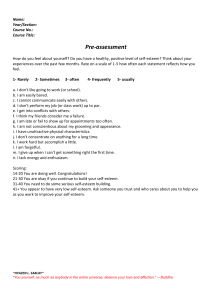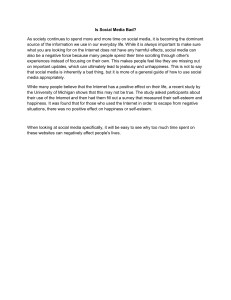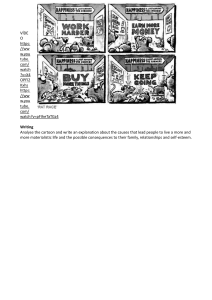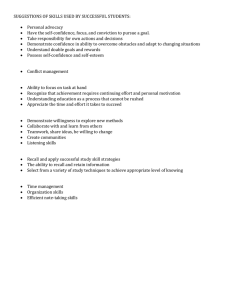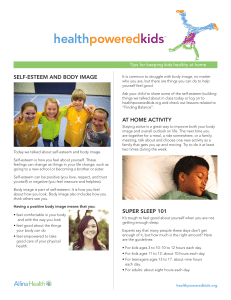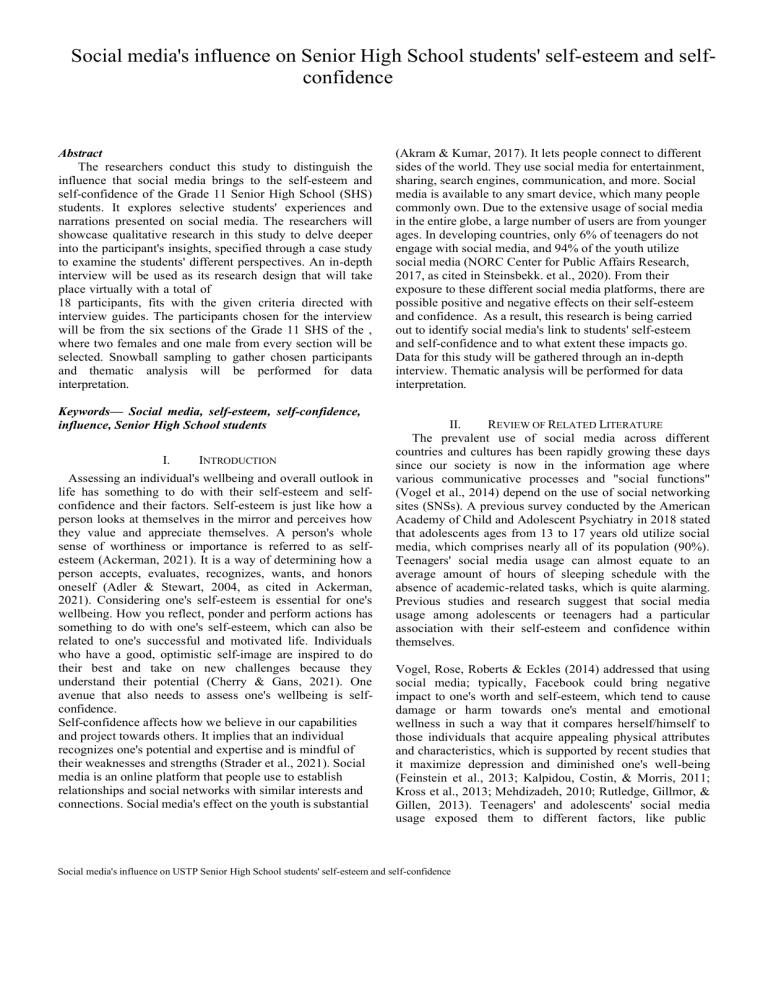
Social media's influence on Senior High School students' self-esteem and selfconfidence Abstract The researchers conduct this study to distinguish the influence that social media brings to the self-esteem and self-confidence of the Grade 11 Senior High School (SHS) students. It explores selective students' experiences and narrations presented on social media. The researchers will showcase qualitative research in this study to delve deeper into the participant's insights, specified through a case study to examine the students' different perspectives. An in-depth interview will be used as its research design that will take place virtually with a total of 18 participants, fits with the given criteria directed with interview guides. The participants chosen for the interview will be from the six sections of the Grade 11 SHS of the , where two females and one male from every section will be selected. Snowball sampling to gather chosen participants and thematic analysis will be performed for data interpretation. Keywords— Social media, self-esteem, self-confidence, influence, Senior High School students I. INTRODUCTION Assessing an individual's wellbeing and overall outlook in life has something to do with their self-esteem and selfconfidence and their factors. Self-esteem is just like how a person looks at themselves in the mirror and perceives how they value and appreciate themselves. A person's whole sense of worthiness or importance is referred to as selfesteem (Ackerman, 2021). It is a way of determining how a person accepts, evaluates, recognizes, wants, and honors oneself (Adler & Stewart, 2004, as cited in Ackerman, 2021). Considering one's self-esteem is essential for one's wellbeing. How you reflect, ponder and perform actions has something to do with one's self-esteem, which can also be related to one's successful and motivated life. Individuals who have a good, optimistic self-image are inspired to do their best and take on new challenges because they understand their potential (Cherry & Gans, 2021). One avenue that also needs to assess one's wellbeing is selfconfidence. Self-confidence affects how we believe in our capabilities and project towards others. It implies that an individual recognizes one's potential and expertise and is mindful of their weaknesses and strengths (Strader et al., 2021). Social media is an online platform that people use to establish relationships and social networks with similar interests and connections. Social media's effect on the youth is substantial (Akram & Kumar, 2017). It lets people connect to different sides of the world. They use social media for entertainment, sharing, search engines, communication, and more. Social media is available to any smart device, which many people commonly own. Due to the extensive usage of social media in the entire globe, a large number of users are from younger ages. In developing countries, only 6% of teenagers do not engage with social media, and 94% of the youth utilize social media (NORC Center for Public Affairs Research, 2017, as cited in Steinsbekk. et al., 2020). From their exposure to these different social media platforms, there are possible positive and negative effects on their self-esteem and confidence. As a result, this research is being carried out to identify social media's link to students' self-esteem and self-confidence and to what extent these impacts go. Data for this study will be gathered through an in-depth interview. Thematic analysis will be performed for data interpretation. II. REVIEW OF RELATED LITERATURE The prevalent use of social media across different countries and cultures has been rapidly growing these days since our society is now in the information age where various communicative processes and "social functions" (Vogel et al., 2014) depend on the use of social networking sites (SNSs). A previous survey conducted by the American Academy of Child and Adolescent Psychiatry in 2018 stated that adolescents ages from 13 to 17 years old utilize social media, which comprises nearly all of its population (90%). Teenagers' social media usage can almost equate to an average amount of hours of sleeping schedule with the absence of academic-related tasks, which is quite alarming. Previous studies and research suggest that social media usage among adolescents or teenagers had a particular association with their self-esteem and confidence within themselves. Vogel, Rose, Roberts & Eckles (2014) addressed that using social media; typically, Facebook could bring negative impact to one's worth and self-esteem, which tend to cause damage or harm towards one's mental and emotional wellness in such a way that it compares herself/himself to those individuals that acquire appealing physical attributes and characteristics, which is supported by recent studies that it maximize depression and diminished one's well-being (Feinstein et al., 2013; Kalpidou, Costin, & Morris, 2011; Kross et al., 2013; Mehdizadeh, 2010; Rutledge, Gillmor, & Gillen, 2013). Teenagers' and adolescents' social media usage exposed them to different factors, like public Social media's influence on USTP Senior High School students' self-esteem and self-confidence attention, opinions, and comments, which significantly impact their self-esteem. Receiving different views of people towards oneself impacts how they live or change their lives. Including those they see on the internet makes them conscious of themselves. Some studies also suggest that social media could embark optimistic self-perception upon oneself because you can decide to appear on your best self-portrait towards the public which in return one can receive such flattering comments and abundant likes depending on how someone perceives it, which could boost one's self-esteem and confidence (Barry et al., 2017). The consequence of acquiring such low self-esteem due to teenagers' social media interaction, especially in girls, is quite alarming, deleterious to one's health and well-being. The previous study conducted by (Chua & Chang, 2016) discovered that due to the rise of the popularity of social media in which mainly all teenage girls engage to where they follow such bandwagon in the socially constructed ideas of beauty upon presenting themselves on social media, which leads to them doing self-harm and treating their body and health poorly just so that they could attain these numerous standards of self-presentation. One useful application of social media is its flexibility to let the users present such a profile which they could beautify, alter and present to various audiences and also that user could share and post pictures of themselves. Such photos being posted on social media typically highlight every user's physical appearance, which they tend to emphasize; this will then push to the uprising of social and self-comparison in the aspects of one's body and beauty upon self-presentation (Fox & Vendemia, 2016). With the complexity of how every individual, primarily teenagers, uses social media, previous studies are pretty limited to teenagers' usage and self-presentation and comparison relating to one's self-esteem and well-being. The researchers aim to provide relevant information into what extent social media could affect the Senior High School students of the University of Science and Technology of Southern Philippines (USTP) to which one can provide practical solutions and intervention unto how they could cope-up with the idealistic world of social media that could eventually promote and boost one's self selfesteem and confidence. III. PROBLEM STATEMENT, PURPOSE OF THE STUDY AND RESEARCH QUESTION/S Social Media is a widely used computer-based technology wherein every individual can share one's thoughts and ideas with just a simple click or press of a button. Its seemingly limitless potential and capabilities have made its reputation as of today, but unfortunately, it also has a counterweight as much as it gives benefits. These counterweights are the disadvantages that threaten future generations as it may affect them physically, mentally, and socially. There are many potential threats to social media. The researchers specifically chose the link between social media and the self-esteem and self-confidence of the Grade11 Senior High School students. Upon crafting this study, it will examine the connection between the socially constructed beliefs of a person's beauty, worth, and value to an own person's perception of himself/herself presented in the online platform, particularly in social media. This current study focuses to determine the influence and link between social media with Senior High School students' selfesteem and self-confidence. This current research will focus on how social media influences oneself in the context of one's self-esteem and self-confidence, what type of activity circulating on social media will be the basis of this influence, and how an individual reacts or responds to this type of activity in social media that will affect one self-esteem and self-confidence which will be determined through identifying its link towards one another. Furthermore, due to quarantine, many people spend most of their time inside their homes, minimizing social interaction with other people, which encourages abnormal social media usage. Thus, this study could potentially help many people, specifically Senior High School students and the youth. IV. RESEARCH DESIGN AND METHODOLOGY Every individual has their own belief and perception of how they view themselves and how they want to appear towards other people. With the emergence of various social networking sites (SNS) and social media, people have developed and created these idealized representations of one's worth, value, and physical attributes. With this current study that the researchers aim to focus on determining the influences and link between social media with the self-esteem and self-confidence of senior high school students. Knowing their insights, opinions, and perceptions towards oneself will be a significant step in understanding the current issue that the researchers aim to address, so the researchers will showcase qualitative research in this study, specified through a case study to examine carefully and intensively investigate the different perspective of Senior High School (SHS) students. To empathize, know the Senior High School students' narration and experiences, and delve deeper into the SHS students' perspective, this research will be using the in-depth interview as its research design that will take place virtually. The interview to be held online via Google meet, zoom, or Facebook messenger depending on the interviewee’s availability. The participants chosen for the interview will be from the six sections of the Grade 11 Senior High School students of the, where two female and one male from every section: name from section Love, Excellence, Aspiration, Discipline, Empathy, and Resilience will be selected. So, a total of 18 students will be interviewed that fits with the given criteria. The current researchers choose the following participants because existing literature suggests that girls are more exposed and vulnerable to social comparison and idealized presentation circulating on social media. The impact on their well-being is high compared to boys (Steinsbekk. et al., 2020). Prior studies were only limited to the participants' upon social media's effects on secondary high school students (Chua & Chang, 2016) and children and adolescents (Steinsbekk. et al., 2020). So, the researchers will focus on Senior High School students. Upon identifying the study participants, snowball sampling will be used, wherein the researchers will identify one person from every section that will fit with the given criteria and that one interviewee will then be the basis of the next interviewee per section for he/she will give suggestions on the following target participants depending on the researchers' qualification of participants. The researchers will ensure that the interviewer's response to the interview will be confidential. The data gathered in the interview will be analyzed and examined through thematic analysis, mainly using the inductive approach. The researchers will be using interview guides for the instrument to be used in interviewing the selected participants. The queries presented in the interview are primarily open-ended subjective and may vary from every person's different perspectives. The data gathered will then be clustered depending on its correlativeness and relevance, with the questions being asked to arrive at fair and appropriate pieces of information. V. RESEARCH SETTING, PARTICIPANTS AND SAMPLING METHOD Upon assessing one's narration and experiences, the researchers will use snowball sampling as its research method to trace the designated participants with their co-participants help. The researchers will be interviewing first one participant from every section, then that participant will recommend the next participant to be interviewed depending on the researchers' criteria. Upon selecting the SHS students that will be chosen to be the participants to be interviewed, the following criteria will be included: (1) a Grade 11 student from the University. (2) he/she must have an active social media accounts (e.g., Facebook, Instagram, Twitter, etc.), (3) he/she is also active on engaging in social media activities such as posting selfies, sharing posts, and commenting on other's post, (4) he/she must be willing to share his/her narrations and experiences in social media regarding insecurities, criticisms and the like. The interview will take place virtually, and no face-to-face interaction will occur. Depending on the participants' convenience and availability, he/she will choose on what video chat app will be used. VI. RESEARCH INSTRUMENT The researchers will be using the in-depth interview to gather different insights, experiences, and narrations from its participants. The interview guide will then be used for the researchers to ask a further question that is open-ended, subjective, and may vary from every participant’s narration and experiences. The data to be gathered will then be analyzed through thematic analysis, depending on the interviewee's narrative. Such questions that will be ask in the interview will range from 5-10 questions, that the first question will tackle about how often do the Senior High School students engage on social media. In order to dig deeper into their experiences, the researchers will then ask questions concerning the things they observed in social media which triggers their insecurities and the way they perceive themselves. REFERENCES Ackerman, C. E. (2021, January 18). What is SelfEsteem? A Psychologist Explains. PositivePsychology.Com. https://positivepsychology.com/self-esteem/ Akram, W., & Kumar, R. (2017). A Study on Positive and Negative Effects of Social Media on Society. International Journal of Computer Sciences and Engineering, 5(10), 351– 354. https://doi.org/10.26438/ijcse/v5i10.351354 Apaolaza, V., Hartmann, P., D’Souza, C., & Gilsanz, A. (2019). Mindfulness, Compulsive Mobile Social Media Use, and Derived Stress: The Mediating Roles of Self-Esteem and Social Anxiety. Cyberpsychology, Behavior, and Social Networking, 22(6), 388–396. https://doi.org/10.1089/cyber.2018.0681 Barry, C. T., Doucette, H., Loflin, D. C., Rivera-Hudson, N., & Herrington, L. L. (2017). “Let me take a selfie”: Associations between self-photography, narcissism, and self-esteem. Psychology of Popular Media Culture, 6(1), 48–60. https://doi.org/10.1037/ppm0000089 Cherry, K., & Gans, S. (2021, March 9). What Are the Signs of Healthy or Low Self-Esteem? Verywell Mind. Retrieved March 31, 2021 from https://www.verywellmind.com/whatis-self-esteem-2795868 Chua, T. H. H., & Chang, L. (2016). Follow me and like my beautiful selfies: Singapore teenage girls’ engagement in self-presentation and peer comparison on social media. Computers in Human Behavior, https://doi.org/10.1016/j.chb.2015.09.011 55, 190–197. International Association for Development of the Information Society. (2016, December). Analysis of Usage Trends of Social Media and Self-Esteem by the Rosenberg Scale (No. ED571615). Kanoh, Hiroko. https://eric.ed.gov/?q=social+media+and+self+esteem&ft=o n&id=ED571615 Steinsbekk, S., Wichstrøm, L., Stenseng, F., Nesi, J., Hygen, B. W., & Skalická, V. (2021). The impact of social media use on appearance self-esteem from childhood to adolescence – A 3-wave community study. Computers in Human Behavior, 114, 106528. https://doi.org/10.1016/j.chb.2020.106528 Strader, S. (n.d.). What is Self-Confidence? Https://Www.Usf.Edu/Student-Affairs/CounselingCenter/Top-Concerns/What-Is-Self-Confidence.Aspx#. Retrieved March 31, 2021, from https://www.usf.edu/student-affairs/counseling-center/topconcerns/what-is-selfconfidence.aspx#:%7E:text=Self%2Dconfidence%20is%20 an%20attitude,assertively%2C%20and%20can%20handle% 20criticism. Vogel, E. A., Rose, J. P., Roberts, L. R., & Eckles, K. (2014). Social comparison, social media, and self-esteem. Psychology of Popular Media Culture, 3(4), 206–222. https://doi.org/10.1037/ppm0000047 Interview Guide 1. Rate from 1-5 (1 – sometimes, 5 – frequently), how often do you post pictures of yourself on social media? 2. Rate 1-5, how often do you share posts about your peers? 3. How many hours a day do you spend on social media? 4. What do you like more, having lots of reactors and followers or just posting with a few likes and comments? 5. How do you feel when you see other people's photos and post online? 6. Do you check on other's profiles? For what reason? 7. Do you often receive compliments online? 8. Do you receive negative feedbacks, comments and criticism online? If yes, how do you respond or react to it?


